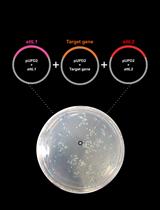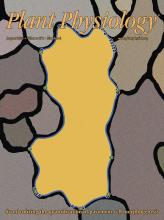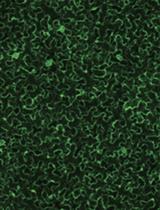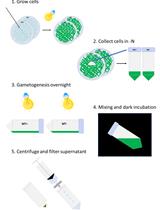- EN - English
- CN - 中文
TUNEL Assay to Assess Extent of DNA Fragmentation and Programmed Cell Death in Root Cells under Various Stress Conditions
各种胁迫条件下根细胞DNA片段化和程序性细胞死亡的TUNEL法评估
发布: 2017年08月20日第7卷第16期 DOI: 10.21769/BioProtoc.2502 浏览次数: 14950
评审: Marisa RosaYingnan HouAnonymous reviewer(s)

相关实验方案

使用Brick into the Gateway (BiG) 实验方法快速克隆细菌基因
Flaviani G. Pierdoná [...] Fabio T. S. Nogueira
2022年12月20日 2297 阅读
Abstract
DNA damage is one of the common consequences of exposure to various stress conditions. Different methods have been developed to accurately assess DNA damage and fragmentation in cells and tissues exposed to different stress agents. However, owing to the presence of firm cellulosic cell wall and phenolics, plant cells and tissues are not easily amenable to be subjected to these assays. Here, we describe an optimized TUNEL (terminal deoxynucleotidyl transferase-mediated dUTP nick-end labeling) assay-based protocol to determine the extent of DNA fragmentation and programmed cell death in plant root cells subjected to various stress conditions. The method described here has the advantages of simplicity, reliability and reproducibility.
Keywords: DNA fragmentation (DNA片段化)Background
Exposure to various stresses generally leads to at least some degree of DNA damage resulting in various lesions such as thymine dimerization, alkylation of bases, single stranded nicks, and double-stranded breaks (Bray and West, 2005; Manova and Gruszka, 2015). Of all types of DNA damage, DNA fragmentation is of particular concern during stress conditions, which may either be a direct effect of the stress (as observed, for example, upon treatment with genotoxic agents) or an indirect effect (predominantly, via excessive generation of reactive oxygen species) or may even be a cumulative consequence of both (Bray and West, 2005; Kapoor et al., 2015). This DNA damage must be accurately repaired by the cell’s repair machinery, failing which there may be deleterious consequences including cell death. For maintaining the normal state, cells utilize the DNA damage response which relies on three non-exclusive events viz. detection/recognition of the damage, its access by the repair machinery and finally its repair (Smerdon, 1991).
One of the major molecular mechanisms of stress adaptation at the cellular level involves the resistance to DNA damage and/or efficient repair of the damaged DNA caused due to stress. Therefore, to assess the stress adaptability of a genotype, accurate assessment of DNA damage is often needed. Two widely-used assays to detect DNA fragmentation in plants are Single Cell Gel Electrophoresis–also known as Comet assay (Santos et al., 2015), and TUNEL [Terminal deoxynucleotidyl Transferase (TdT)-mediated dUTP Nick-End Labeling] assay. In comet assay, the tissue of interest is sliced and the resulting cell suspension containing nuclei is embedded in an agarose matrix followed by its alkaline electrophoresis and staining with DAPI/ethidium bromide. After electrophoresis, micrographs show the appearance of broken DNA like a tail similar to that of a comet while the undamaged and condensed DNA appears like a spherical mass forming the head of the comet (Wang et al., 2013). Comet assay, though quite useful, has a few limitations. For instance, it requires isolated nuclei, and hence gives no information on the distribution of DNA damage in a given tissue as well as regarding programmed cell death (PCD). The other widely-used assay–TUNEL assay, can be used to detect in situ DNA strand breaks. TUNEL assay is based on incorporation of labeled dUTP in the DNA (mediated by the enzyme terminal deoxynucleotidyl transferase) which occurs only at the regions with free 3’ termini (i.e., breaks or extreme ends of the chromosome) (Gavrieli et al., 1992). Besides, as breaks in inter-nucleosomal DNA often lead to programmed cell death, TUNEL assay provides significant information about PCD. TUNEL assay, in its basic form, also offers the advantages of simplicity and can give an idea about the distribution of DNA fragmentation (TUNEL-positive cells) in the tissue being studied.
Plant tissues are not easily amenable to some of the steps of TUNEL assay. The major reasons for this are: difficulty in permeabilization due to the presence of cellulosic cell wall and potential inhibition of TdT-catalyzed reaction by phenolics present in the plant cells. Due to these reasons, TUNEL assay is not a frequently utilized procedure for assessment of DNA fragmentation and PCD in plants. A few recent studies, nonetheless, have shown the application of TUNEL assay in rice (Kwon et al., 2013) and Arabidopsis (Phan et al., 2011; Yang et al., 2014). However, most of these studies have used microtomy/ultramicrotomy and ‘paraffin section’ preparation–a procedure which is not very easy, and requires somewhat expensive instrumentation and technical expertise. Given the range of information which TUNEL assay can provide, especially when determining the stress adaptability of plant genotypes, and its advantages in comparison to other methods, there is a need to develop a standardized, easy-to-follow and relatively inexpensive protocol for TUNEL assay using plant tissues.
Here, we describe an optimized TUNEL assay-based protocol to assess the extent of DNA fragmentation and programmed cell death in plant root cells under various stress conditions. The protocol presented here describes, in detail, a more generalized version of the methodology used for TUNEL assay in our recent study (Tripathi et al., 2016). While we often use this method to study DNA damage and PCD in root tissue from rice and Arabidopsis, it can also be utilized to study these phenomena in root tissue from other herbaceous plants with some minor modifications as detailed in the ‘Procedure’ section. The method presented here is quite easy-to-follow, reliable and reproducible.
Materials and Reagents
- 1-200 μl pipet tips (DNase-free) (Corning, USA)
- 0.2-2 μl pipet tips (DNase-free) (Corning, USA)
- 100-1,000 μl pipet tips (DNase-free) (Corning, USA)
- Razor blade (any standard make)
- 1.5 ml and 2 ml microcentrifuge tubes (DNase-free) (Corning, USA)
- 15 ml and 50 ml centrifuge tubes (DNase-free) (Corning, USA)
- Aluminium foil (any standard make)
- Glass slides (any standard make)
- Cover slips (any standard make)
- 1-4 weeks old rice (Oryza sativa cv. IR64) seedlings (see Note at the beginning of the ‘Procedure’ section)
- Ethanol (Sigma-Aldrich, catalog number: 24102 )
Note: This product has been discontinued. - ProLong® Gold Antifade mountant with DAPI (Thermo Fisher Scientific, InvitrogenTM, catalog number: P36931 )
- DeadEndTM Fluorometric TUNEL System (Promega, catalog number: G3250 )
Note: *In case the DeadEndTM Fluorometric TUNEL System (Promega, catalog number: G3250 ) is being used, then the chemicals/reagents marked with an asterisk (*) need not be procured. See Note 2 below. - Sodium chloride (NaCl) (AMRESCO, catalog number: 0241 )
- Potassium chloride (KCl) (AMRESCO, catalog number: 0395 )
- Sodium phosphate dibasic (Na2HPO4) (AMRESCO, catalog number: 0404 )
- Potassium phosphate monobasic (KH2PO4) (AMRESCO, catalog number: 0781 )
- Paraformaldehyde powder (Sigma-Aldrich, catalog number: 158127 )
- Citric acid monohydrate (Sigma-Aldrich, catalog number: C1909 )
- Trisodium citrate dihydrate (Sigma-Aldrich, catalog number: S1804 )
- Triton X-100 (Sigma-Aldrich, catalog number: T8787 )
- Tris(hydroxymethyl)aminomethane (Sigma-Aldrich, catalog number: 252859 )
- Sodium cacodylate* (Sigma-Aldrich, catalog number: C4945 )
- Cobalt(II) chloride hexahydrate* (Sigma-Aldrich, catalog number: C8661 )
- Dithiothreitol (DTT) (Sigma-Aldrich, catalog number: 10708984001 )
Manufacturer: Roche Diagnostics, catalog number: 10708984001 . - Bovine serum albumin (BSA) (AMRESCO, catalog number: 0332 )
- Ethylenediaminetetraacetic acid (EDTA) (Sigma-Aldrich, catalog number: 03620 )
- Fluorescein-12-dUTP* (Thermo Fisher Scientific, Thermo ScientificTM, catalog number: R0101 )
- dATP* (Promega, catalog number: U1202 )
- Terminal Deoxynucleotidyl Transferase, Recombinant (rTdT)* (Promega, catalog number: M1871 )*
- Sodium citrate
- Hydrochloric acid (HCl)
- Propidium iodide (PI) (Sigma-Aldrich, catalog number: 81845 )
- DNase-free proteinase K (Thermo Fisher Scientific, InvitrogenTM, catalog number: AM2544 )
- 1x phosphate buffered saline (PBS), pH 7.4 (see Recipes)
- Fixative buffer (see Recipes)
- 100 mM citric acid solution (see Recipes)
- 100 mM trisodium citrate dihydrate solution (see Recipes)
- 100 mM sodium citrate buffer, pH 6.0 (see Recipes)
- Permeabilization solution (see Recipes)
- Proteinase K (see Recipes)
- Equilibration buffer (see Recipes)
- Nucleotide mix (see Recipes)
- TUNEL reaction mix (see Recipes)
- 20x saline-sodium citrate (SSC) buffer (see Recipes)
- 2x saline-sodium citrate (SSC) buffer (see Recipes)
- Propidium iodide stock solution (1 μg/μl) (see Recipes)
Equipment
- 0.2-2 μl pipette (Gilson, PIPETMAN Classic®)
- 2-200 μl pipette (Gilson, PIPETMAN Classic®)
- 100-1,000 μl pipette (Gilson, PIPETMAN Classic®)
- Glass beakers of volume 20 ml, 50 ml, and 100 ml (Schott Duran, Germany)
- Reagent bottles, glass of volume 50 ml, 100 ml, 500 ml, and 1,000 ml (any standard make)
- Laboratory fume hood (any standard make)
- Magnetic stirrer (Genetix Brand, India)
- Water bath (any standard make)
- Confocal microscope (Nikon, model: Nikon A1R )
Software
- ImageJ Standard version 1.46r (http://imagej.net/mbf/)
- NIS Elements AR (Nikon, Japan) or a comparable software for confocal microscope image acquisition and analysis
Procedure
文章信息
版权信息
© 2017 The Authors; exclusive licensee Bio-protocol LLC.
如何引用
Readers should cite both the Bio-protocol article and the original research article where this protocol was used:
- Tripathi, A. K., Pareek, A. and Singla-Pareek, S. L. (2017). TUNEL Assay to Assess Extent of DNA Fragmentation and Programmed Cell Death in Root Cells under Various Stress Conditions. Bio-protocol 7(16): e2502. DOI: 10.21769/BioProtoc.2502.
- Tripathi, A. K., Pareek, A. and Singla-Pareek, S. L. (2016). A NAP-family histone chaperone functions in abiotic stress response and adaptation. Plant Physiol 171(4): 2854-2868.
分类
植物科学 > 植物分子生物学 > DNA > DNA 修饰
分子生物学 > DNA > DNA 标记
您对这篇实验方法有问题吗?
在此处发布您的问题,我们将邀请本文作者来回答。同时,我们会将您的问题发布到Bio-protocol Exchange,以便寻求社区成员的帮助。
Share
Bluesky
X
Copy link










